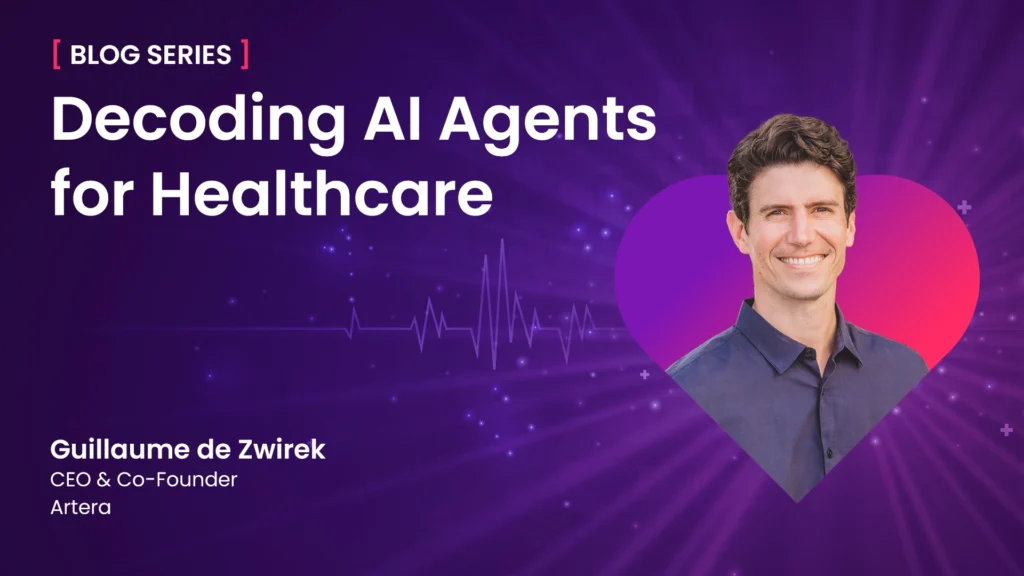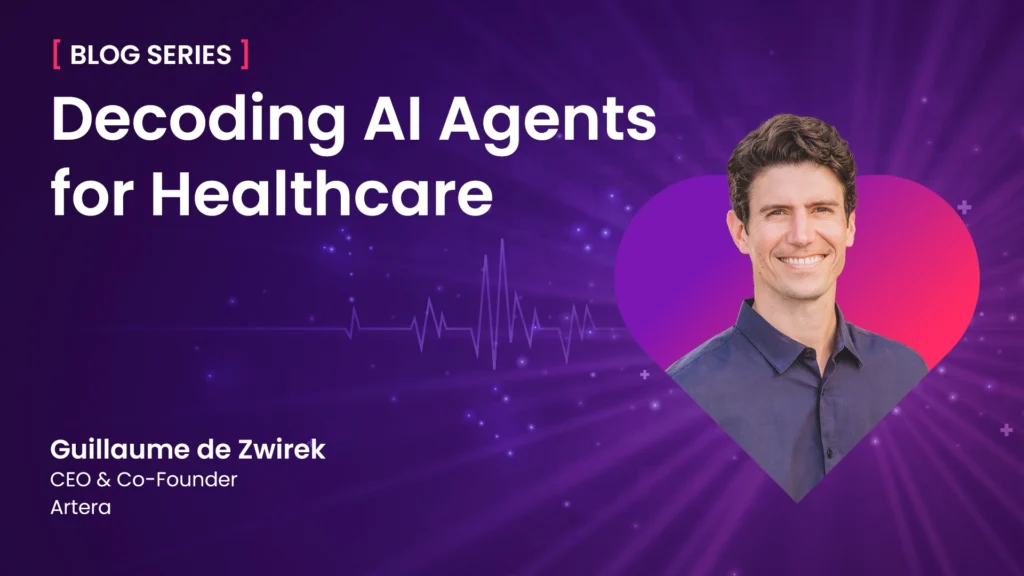As a health system executive, you’re likely at a crossroads that could define your company’s competitive advantage for the next decade. Agentic AI is emerging as the next breakthrough, making the real question not if you should embrace it, but how to integrate it effectively.
While tools like ambient AI scribes have made AI a common term in healthcare, the next frontier is automating high-volume operational tasks. To get there, you have three options: build your own solutions, buy off-the-shelf products, or partner with a specialized vendor.
Understanding Agentic AI
Agentic AI represents a sophisticated convergence of multiple technologies working together to create human-like interactions that can complete complex tasks autonomously. Unlike simple chatbots or single-function AI tools, these systems integrate multiple technologies, including large language models, AI-generated voice capabilities, speech transcription and new standards like MCP for connecting AI systems to software.
Here are some real-world healthcare applications of agentic AI:
- Appointment scheduling
- Prescription management
- Password resets
- Insurance collection
- Bill processing
Artera data reveals that a substantial 45 percent of call center inquiries revolve around appointment verification, cancellations, and rescheduling. These are prime candidates for AI automation.
These AI agents work around the clock, 24/7, delivering consistent service and taking care of routine tasks that used to require human staff. The technology has matured to the point where it can deliver human-like experiences that often outperform traditional call center performance in speed, accuracy and experience.
Build vs. Buy vs. Partner
AI Tech Stack: “The Metal”
Before we dive into the three approaches, let’s take a moment to break down the key layers needed to build an AI Agent. Think of these layers as building blocks, often provided by different vendors and serving various needs. I like to refer to this AI tech stack as “the metal.”
- Large Language Models (LLMs): Understands & generates human-like text; there are many model providers, and the best depends on the use-case and modality (e.g. Gemini Flash 2.5 or OpenAI Realtime are the lowest latency as of this writing)
- Vendors include Anthropic (Claude), OpenAI (ChatGPT), Google (Gemini), Meta (Llama), X1 (Grok), Deepseek (R1), Kimi (K2)
- Orchestration: Foundation layer that simplifies the process of integrating large language models with tools, while providing base observability and scalability for your agents
- Vendors include AWS (Bedrock, Strands), Google (Vertex AI), Pipecat, LangChain
- Real-Time Voice: Includes two core services, often provided by distinct vendors depending on the use case. Speech-to-text (STT) transcribes audio into text, text-to-speech (TTS) turns LLM text output into spoken word, most typically using an “AI-generated voice” that is lifelike and infinitely customizable.
- STT vendors include Google, Deepgram, Nuance and many others
- TTS vendors include ElevenLabs, Cartesia, Murf, and many others
- Telephony: The core gateway connection into all the telecommunications and email (SMTP, POP3, IMAP) providers. For the most versatile agent, you will want to consider voice (PBX or SIP/VOIP), SMS, RCS, and email.
- Vendors include Twilio, Sinch, Syniverse, Cisco and many more
- Tools: In healthcare, the “skills” you want your AI agent to fulfill (e.g. scheduling, prescription refill, insurance update) typically exist in the EHR/PM and are accessed via FHIR, HL7, SFTP or custom web services. As of this writing, best practice for leveraging tools involves creating a “translation” layer using an open standard like Model Context Protocol (MCP), which enables large language models to interact reliably with outside software. Think of MCP as the translator that allows AI agents to speak fluently with your existing healthcare systems, ensuring they can access patient information, update records, and complete transactions with the same reliability as human staff, but with greater consistency and availability.
- Evaluation: A high-performing AI agent requires significant prompt engineering, wherein the instructions for the LLM are tweaked to reliably achieve the desired outcome. Evaluation frameworks allow your agents to simulate “real-world” situations to test for accuracy, safety, helpfulness, etc., before being deployed to production. The best AI systems will further implement a back-end “judge” that feeds real-life transcripts into the evaluation framework for continuous monitoring and improvement.
Building In-House AI Agents
The first approach, building an AI Agent in-house, demands substantial technical expertise and financial investment. This involves engaging with the lowest-level infrastructure and meticulously integrating the various components listed above. By carefully stitching these together, one could construct a bespoke solution.
In this case, however, constructing a bespoke solution means you must work and maintain direct relationships with core AI Infrastructure providers to find solutions tailored to your needs, navigating a complex landscape and purchasing from each of them individually.
Advantages:
- Complete control over tech stack and implementation
- Customization aligned with specific organizational needs
- Highest quality product (provided the right supporting team)
- Lowest transaction costs (provided large enough volume)
Disadvantages:
- $3M minimum ongoing annualized investment (minimum of 2 Devops Engineers, 2 Machine Learning Engineers, 2 Senior Software Engineers, 1 Product Manager + hosting and software spend)
- Need for specialized in-house talent across multiple languages, e.g. Python for ML, YAML, JSON and JavaScript for SWE, and being current on various AI-specific standards like A2A and MCP
- Ongoing maintenance, all while staying up to speed with the latest technology advancements and agility to replace as new benchmarks emerge
Purchasing an Off-the-Shelf AI Agent (OEM Vendor)
Alternatively, health systems can work with a vendor that essentially rebrands a horizontal provider’s technology as their own: a practice known as OEMing (Original Equipment Manufacturing). OEM vendors provide a wrapper around existing middleware platforms (e.g. Vapi.ai or Bland.ai) that facilitate the creation of AI Agents, but are not specifically designed for healthcare.
This approach can mean paying double the actual technology cost while limiting direct access to the latest innovations and updates of the core provider within the AI Tech Stack or “the metal.”
Advantages:
- Single point of contact/vendor to manage
- Faster implementation timeline compared to building in-house
- Lower upfront costs compared to building in-house
Disadvantages:
- Higher long-term costs due to markup on underlying technology
- Limited customization capabilities
- Dependence on third-party middleware providers
- Less secure (additional entry point into your systems)
- Less agility and control
Another more preferable option (assuming in-house expertise around AI integration standards and baseline development capacity) would be a healthcare organization acting as its own OEM and integrating directly with the middleware platforms mentioned above. This will reduce vendor costs, while increasing maintenance spend and providing more direct control over the end product.
Partnering with AI Healthcare-Specialized Vendors
To steer clear of the above issues, I suggest health systems skip third-party vendors and work directly with those plugged directly into the metal.
Which leads us to the third option: contracting with a vendor focused exclusively on healthcare (healthcare-vertical providers), who have direct access to those in the AI tech stack. Specialized healthcare AI vendors typically invest millions or more in developing healthcare-specific solutions, understanding the unique requirements of healthcare interoperability, security, and compliance, while maintaining direct relationships with core AI infrastructure providers.
Essentially, these vendors orchestrate and bundle all of the AI tech stack components / technology into a simple solution for healthcare providers, making it the fastest and most cost-effective way to deploy AI Agents.
Advantages:
- Healthcare-specific expertise and compliance knowledge
- Direct integration with core AI infrastructure
- Proven real-world deployment experience
- Shared investment in healthcare-relevant innovations
- Faster time to value with lower risk
- Many customization capabilities
Disadvantages:
- Dependence on partner’s technology roadmap
- Limited control over underlying technology decisions
The Core Tradeoff: Control Versus Speed
At its core, the build versus buy versus partner decision comes down to a tradeoff between control and speed.
Building in-house gives you full ownership of your tech stack, deeper integration into internal systems, and full control of sensitive data. However, it often requires longer development timelines, and significant upfront and ongoing investment
Buying off-the-shelf may offer faster deployment and lower initial costs (versus building), but can limit your ability to customize, restrict access to core data, and create long-term scalability issues.
The more strategic approach for many healthcare organizations is to partner with a vendor that understands the unique complexity of healthcare systems. By working with Artera, health systems accelerate time to value, leveraging years of specialized expertise, a compliant AI infrastructure, and deep integrations already built for real-world deployment. This approach reduces risk and cost while giving you the flexibility to scale with confidence.
Choosing between these paths is not always a binary decision. In many cases, the optimal strategy is a hybrid model that combines the customization benefits of in-house development with the speed, scalability, and stability of a proven AI partner like Artera.
Lessons Learned
We’ve spent years investing in AI, and with the rapid rise of Agentic AI, we’ve quickly embraced, configured and deployed it for many of our customers. Here’s what we’ve learned along the way…
Technology Evolution Speed
The pace of change in Agentic AI is unprecedented. Technologies that required significant custom development just months ago are now available as standard features from major providers. This rapid evolution makes long-term technology investments particularly risky for organizations building in-house solutions.
Security and Compliance Complexity
Agentic AI systems are advancing at a rapid pace, requiring a fundamental shift in how we approach data security. Traditional static, point-in-time assessments are no longer sufficient. Instead, safeguarding these dynamic systems calls for continuous monitoring, robust multi-layered security frameworks, and a seamless integration of human oversight with AI-driven validation.
Real-World Deployment Value
The competitive advantage lies not in the underlying AI technology itself, but in healthcare-specific implementation experience. Understanding how to handle edge cases, manage patient interactions, and integrate with healthcare workflows requires extensive domain expertise.
Cost Structure Reality
The current pricing for AI solutions is unsustainable at scale. Similar to the dot-com boom, the current market is subsidized, with artificially low AI prices. When the inevitable market correction happens, many vendors won’t survive. Therefore, organizations must partner with vendors that are not only financially stable enough to withstand the crash but also have sustainable business models for long-term success.
Today’s healthcare market is saturated with AI agent solutions, making vendor evaluation difficult for healthcare providers amidst similar claims and significant costs.
To simplify your evaluation, we’ve identified the top five factors that distinguish Artera’s AI agents today. Whether you’re new to AI agents or well into your research for a partner, we hope this distillation proves valuable.
Artera’s blog posts and press releases are for informational purposes only and are not legal or business advice. Artera assumes no responsibility for the accuracy, completeness, or timeliness of blogs and non-legally required press releases. Claims for damages arising from decisions based on this release are expressly disclaimed, to the extent permitted by law.



